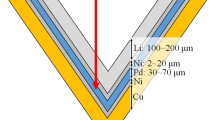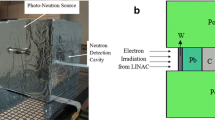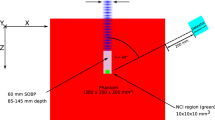Abstract
Neutron capture therapy with Sulfur-33, similar to boron neutron capture therapy with Boron-10, is effective in treating some types of tumors including ocular melanoma. The key point in sulfur neutron capture therapy is whether the neutron beam flux and the resonance capture cross section of \(^{33}\hbox {S(n},\alpha )^{30}\hbox {Si}\) reaction at 13.5 keV can achieve the requirements of radiotherapy. In this research, the authors investigated the production of 13.5 keV neutron production and moderation based on an accelerator neutron source. A lithium glass detector was used to measure the neutron flux produced via near threshold \(^{7}\hbox {Li(p,n)}^{7}\hbox {Be}\) reaction using the time-of-flight method. Furthermore, the moderation effects of different kinds of materials were investigated using Monte Carlo simulation.







Similar content being viewed by others
References
J. Chadwick, The existence of a neutron. Proc. R. Soc. 136, 692 (1932). https://doi.org/10.1098/rspa.1932.0112
G.L. Locher, Biological effects and the therapeutic possibilities of neutrons. Am. J. Roentgenol. 36, 1 (1936)
L.E. Farr, W.H. Sweet, H.B. Locksley et al., Neutron capture therapy of gliomas using boron. Trans. Am. Neurol. Assoc. 13, 110 (1954)
R.L. Moss, Critical review, with an optimistic outlook, on boron neutron capture therapy (BNCT). Appl. Radiat. Isot. 88, 2 (2014). https://doi.org/10.1016/j.apradiso.2013.11.109
I. Porras, Sulfur-33 nanoparticles: a Monte Carlo study of their potential as neutron capturers for enhancing boron neutron capture therapy of cancer. Appl. Radiat. Isot. 69, 1838 (2011). https://doi.org/10.1016/j.apradiso.2011.04.002
M. Sabaté-Gilarte, J. Praena, I. Porras et al., Measurement of the \(^{33}\)S(n,\(\alpha\)) cross section at n\_TOF(CERN): applications to BNCT. Rep. Pract. Oncol. Radiother. 21, 113 (2016). https://doi.org/10.1016/j.rpor.2014.08.007
C. Wagemans, H. Weigmann, R. Barthelemy, Measurement and resonance analysis of the \(^{33}\)S(n,\(\alpha\)) cross section. Nucl. Phys. A 469, 497 (1987). https://doi.org/10.1016/0375-9474(87)90035-2
I. Porras, Enhancement of neutron radiation dose by the addition of sulphur-33 atoms. Phys. Med. Biol. 53, L1 (2008). https://doi.org/10.1088/0031-9155/53/7/L01
I. Porras, J. Praena, M. Sabatégilarte et al, \(^{33}\)S(n,\(\alpha\)) cross section measurement at n\_TOF: implications in neutron capture therapy. http://digital.csic.es/handle/10261/123302
J. Praena, M. Sabaté-Gilarte, I. Porras et al., \(^{33}\)S as a cooperative capturer for BNCT. Appl. Radiat. Isot. 88, 203 (2014). https://doi.org/10.1016/j.apradiso.2013.12.039
I. Porras, P.L. Esquinas, M.G. Feldmann et al., A potential selective radiotherapy for ocular melanoma by sulfur neutron capture, in 16th International Congress on Neutron Capture Therapy (ICNCT-16) , Helsinki, Finland, June 14–19 (2014)
J. Praena, Experimental study of the 13.5 keV resonance of the \(^{33}\)S(n,\(\alpha\))\(^{30}\)Si reaction at CERN n\_TOF fa-cility for BNCT, in 16th International Congress on Neutron Capture Therapy (ICNCT-16), Helsinki, Finland, June 14–19 (2014)
I. Porras, M. Sabaté-Gilarte, J. Praena et al., \(^{33}\)S for neutron capture therapy: nuclear data for Monte Carlo calculations. Nucl. Data Sheets 120, 246 (2014). https://doi.org/10.1016/j.nds.2014.07.058
M. Sabaté-Gilarte, The \(^{33}\)S(n,\(\alpha\))\(^{30}\)Si cross section measured at n\_TOF Experimental Area 2(CERN): from thermal to the resolved resonance region, in International Nuclear Data Conference for Science and Technology (ND2016), Bruges, Belgium , September 11–16 (2016)
M. Sabaté-Gilarte, J. Praena, I. Porras et al., Measurement of the \(^{33}\)S(n,\(\alpha\)) cross section at n\_TOF(CERN): applications to BNCT. Reports Prac. Onco. Radio 21, 113 (2016). https://doi.org/10.1016/j.rpor.2014.08.007
T.E. Blue, J. Yanch, Accelerator-based epithermal neutron sources for boron neutron capture therapy of brain tumors. J. Neuro-Oncol. 62, 19 (2003)
D.M. Minsky, A.J. Kreiner, Near threshold \(^7\)Li(p, n)\(^7\)Be reaction as neutron source for BNCT. Appl. Radiat. Isot. 106, 68 (2015). https://doi.org/10.1016/j.apradiso.2015.07.038
K.V.K. Iyengar, S.K. Gupta, K.K. Sekharan et al., Fluctuations in the integrated cross section of the reaction \(^{45}\)Sc(p, n)\(^{45}\)Ti. Nucl. Phys. A 96, 521 (1967). https://doi.org/10.1016/0375-9474(67)90602-1
M.S. Herrera, G.A. Moreno, A.J. Kreiner et al., New method to evaluate the \(^7\)Li(p, n)\(^7\)Be reaction near threshold. Nucl. Instrum. Meth. B 349, 64 (2015). https://doi.org/10.1016/j.nimb.2015.01.080
R. Mateus, A.P. Jesus, B. Braizinha et al., Proton-induced \(\gamma\)-ray analysis of lithium in thick samples. Nucl. Instrum. Meth. B 190, 117 (2002). https://doi.org/10.1016/S0168-583X(01)01222-8
D. Schlegel, Target User’s Manual. Abteilung Ionisierende Strahlung Laborbericht (2005)
D. Schlegel, S. Guldbakke, Why do We Need Target? (Springer, Berlin, 2001), p. 881
IAEA-TECDOC-1223, Current Status of Neutron Capture Therapy, (International Atomic Energy Agency, Austria, 2001)
Geant4 Collaboration, User’s Guide: For Application Developers (2015). http://geant4.web.cern.ch/geant4/UserDocumentation/UsersGuides/ForApplicationDeveloper/BackupVersions/V10.2/fo/BookForAppliDev.pdf
Geant4 Collaboration, Physics Reference Manual (2015). http://geant4.web.cern.ch/geant4/UserDocumentation/UsersGuides/PhysicsReferenceManual/fo/PhysicsReferenceManual.pdf
C.L. Lan, M. Peng, Y.Z. et al., Geant4 simulation of \(^{238}\)U(n,f) reaction induced by D-T neutron source. Nucl. Sci. Tech. 28, 8 (2016). https://doi.org/10.1007/s41365-016-0158-7
B. Yang, X. Guan, X. Cao et al., Progresses in the project of upgrading HI-13 tandem accelerator at CIAE. Nucl. Tech. 31, 41 (2008). (in Chinese)
Q.W. Zhang, G.Z. He, X.C. Ruan et al., Calibration of neutron detection efficiency of li-glass detector. Nucl. Phys. Rev. 34, 2460 (2013). https://doi.org/10.11804/NuclPhysRev.30.02.156. (in Chinese)
G.F. Auchampaugh, J. Halperin, R. L. Macklin et al., Kilovolt \(^{33}\text{S}(n, {\alpha }_{0})\) and \(^{33}\text{ S }(n, {\gamma })\) cross sections: Importance in the nucleosynthesis of the rare nucleus \(^{36}\text{ S }\). Phys. Rev. C 12, 1126 (1975). https://doi.org/10.1103/PhysRevC.12.1126
P.E. Koehler, J.A. Harvey, N.W. Hill, Two detectors for (n, p) and (n,\(\alpha\)) measurements at white neutron sources. Nucl. Instrum. Meth. A 361, 270 (1995). https://doi.org/10.1016/0168-9002(95)00123-9
Author information
Authors and Affiliations
Corresponding author
Rights and permissions
About this article
Cite this article
Peng, M., He, GZ., Zhang, QW. et al. Study of neutron production and moderation for sulfur neutron capture therapy. NUCL SCI TECH 30, 2 (2019). https://doi.org/10.1007/s41365-018-0529-3
Received:
Revised:
Accepted:
Published:
DOI: https://doi.org/10.1007/s41365-018-0529-3




